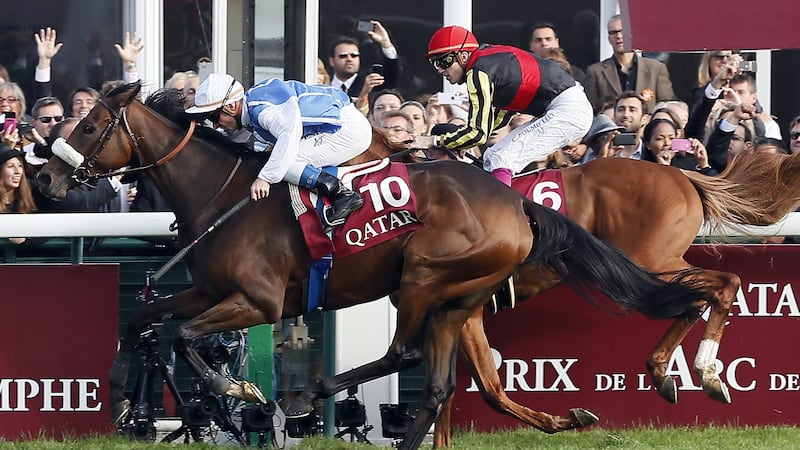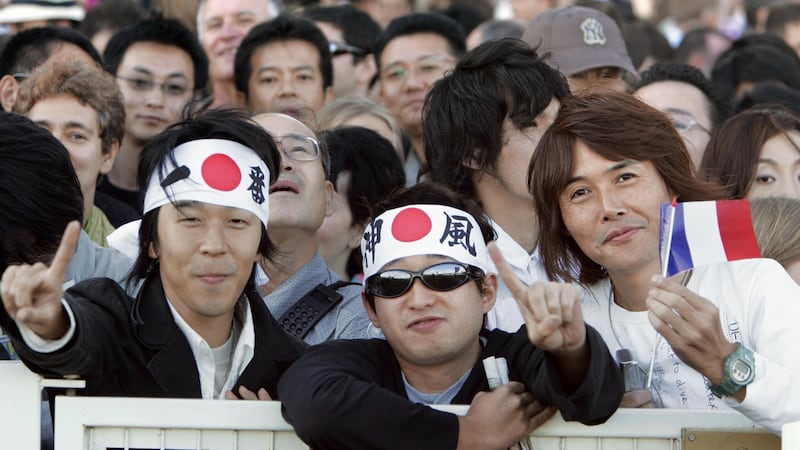This weekend 15 years ago 22 million Japanese viewers tuned in to watch the Qatar Prix de l'Arc de Triomphe.
That’s almost 20 per cent of Japan’s population watching a horse race on the other side of the world – at 2am. It underlines what continues to be one of the most unlikely national obsessions in world sport.
Japan has been trying to win the Arc since 1969. Speed Symboli was the first exotic visitor from the Far East to line up at Longchamp on the opening Sunday of October. He was the best at home. But, against Europe's elite, Speed Symboli could manage only 10th behind the Irish winner Levmoss.
It prompted some national embarrassment, shattered a few delusions, and helped spark the transformation of Japanese racing from backwater to world leader in just three decades.
Backed by government, and with prodigious prizemoney generated by betting turnover, billions was invested on importing the best European and US bloodlines.
The outcome is a racing environment the envy of almost every other major racing jurisdiction, not least in terms of massive public popularity that explains 20 per cent of Tokyo and Osaka watching a race at two in the morning.
Much of that is tied up with gambling but it’s far from the full story. Japan’s top jockeys have celebrity profiles. The best horses inspire wildly enthusiastic fan-bases. At the top meetings, crowds of up to 100,000 generate an atmosphere more akin to a soccer stadium than the reserved enclosure.
So when Deep Impact lined up for the Arc in 2006 it felt like destiny, a perfect international denouement to a remarkable success story.
The son of the Kentucky Derby winner Sunday Silence was an outstanding Japanese Triple Crown winner and ridden by the country's top rider, Yutaka Take. An estimated 15,000 fans travelled to Longchamp from Japan to watch him win first-hand. Weight of visiting money made Deep Impact an odds-on favourite. Bets were made solely for tickets to be kept for 'I was there' purposes.
And then Deep Impact fluffed his lines by finishing only third. Those at Longchamp that day recall stunned Japanese fans weeping as they left the grandstand. More salt was rubbed into those tears when Deep Impact was later disqualified from third for failing a dope test. Destiny had turned into disaster.
Quite why the Arc has became such a ‘Holy Grail’ to Japanese racing is difficult to precisely pin down.
Greatest stars
It is long established that its domestic standards rank with the best of European and US racing. Although runners from Japan have been successful around the globe – including in top Australian races such as the Melbourne Cup – prizemoney levels usually make it more lucrative to stay at home. Even the riches available at the Breeders Cup don’t encourage the Japanese to travel there much.
Yet the prospect of Arc success repeatedly lures Japan’s greatest stars to Paris.
Crucial to that perhaps was how close El Condor Pasa came to victory in 1999. On boggy ground the raider came within a whisker of successfully making all the running. Only the outstanding Montjeu managed to overhaul him. Initial disappointment mixed with pride at a superb display that suggested Arc glory for Japan was a case of ‘when’ and not ‘if’.

Deep Impact’s reverse sharply knocked that confidence. In 2012 it seemed the fates played a cruel trick in the defeat of another Triple Crown champion, Orfevre.
The quirky chestnut sauntered to the lead under Christophe Soumillon with victory apparently in the bag. In the closing strides however Orfevre inexplicably jinked, allowing the unheralded Solemia to rally. There were no excuses a year later when he was runner-up again but it added to growing frustration that still somehow hasn't shaken the obsession. It has become about national pride.
"It's totally true. It's all in on the Arc until they win it," agrees former jockey and TV pundit Fran Berry who was a visiting rider in Japan for several years.
"I've asked the same question, why the Arc and not the Epsom Derby or the King George. But there is a connection that goes back ages. And every since Deep Impact getting beat and Nakayama Festa (runner-up in 2010) and Orfevre getting beat it's built up more and more. Whatever can travel goes to France, " he added.
Curragh trainer Willie McCreery also spent some time working in Japan and was struck by how keen the racing industry there is to be perceived positively in Europe.

“It would mean the world to them, winning outside the continent, coming to Europe and winning. They love the elegance of the whole French thing and the Arc is huge. They love to be able to compete outside of Japan, to be seen on an equal stage, because they’re not seen as being on an equal stage just running in Japan,” he said.
“They are obsessive about the Arc. No one ever explained it to me but they are. But they’re obsessive about anything they’re really into and fanatical about their racing,” he added.
On Sunday there will be a two-pronged Japanese attempt to finally get the job done. Deep Bond beat Aidan O’Brien’s Broome in an Arc trial, the Prix Foy, at Longchamp last month. However it is the mare Chrono Genesis who looks to the be the number one hope. Killarney’s own champion jockey Oisín Murphy was engaged months ago for the ride.
Classic horses
Chrono Genesis is a proven Group One winner at home and last spring was an unlucky second to one of Europe's top horses, Mishriff, at the Dubai World Cup meeting. Dermot Weld has nominated her as as big a threat to his own hope Tarnawa as European classic horses like Aidan O'Brien's Snowfall and the Godolphin pair of Derby heroes, Adayar and Hurricane Lane.
As a daughter of the 2004 Arc winner Bago, she is an example of imported blood moulded to Japanese preparation and performance. Underlining the fluid nature of elite international competition is how Snowfall’s sire is no less than Deep Impact. Deep Bond is a son of Kizuna who ran fourth in the 2013 Arc.
“When I was in Japan they tried bringing horses to France in the summer time for the trial runs. The horse that won recently [Deep Bond] has taken that route. It’s different with Chrono Genesis who is flying in late. They have tried every which way to see what works best to get them there in peak shape,” Fran Berry points out.
That cracking the code has remained stubbornly impossible for so long doesn’t appear to have diluted Japanese hopes of finally getting it done. If anything it seems to have only copper-fastened the great race’s appeal. Europe’s greatest all-aged race has always been about excellence but never more so than on the other side of the globe.
It’s why millions in Japan will again get up at an ungodly hour in the middle of the night to watch another tilt at Arc glory and why the result will be more significance to a lot more people than just another winning bet. Victory will be vindication of an obsession that has endured for over half a century. The 100th Arc could hardly have a more suitable or more significant success to celebrate.
Past Japanese Arc Performances:
1969 Speed Symboli 10th
1972 Mejiro Musashi 18th
1986 Sirius Synboli 14th
1999 El Condor Pasa 2nd
2002 Manhattan Cafe 13th
2004 Tap Dance City 17th
2006 Deep Impact 3rd - later disqualified
2008 Meisho Samson 8th
2010 Nakayama Festa 2nd
Victorie Pisa 7th
2011 Hiruno d'Amour 10th
Nakayama Festa 11th
2012 Orfevre 2nd
Aventino 17th
2013 Orfevre 2nd
Kizuna 4th
2014 Harp Star 6th
Just Away 8th
Gold Ship 14th
2016 Makahiki 14th
2017 Satano Diamond 15th
Satanao Noblesse 16th
2018 Clincher 17th
2019 Kiseki 7th
Blast Onepiece 11th
Fierement 12th
2020 Deirdre 8th













